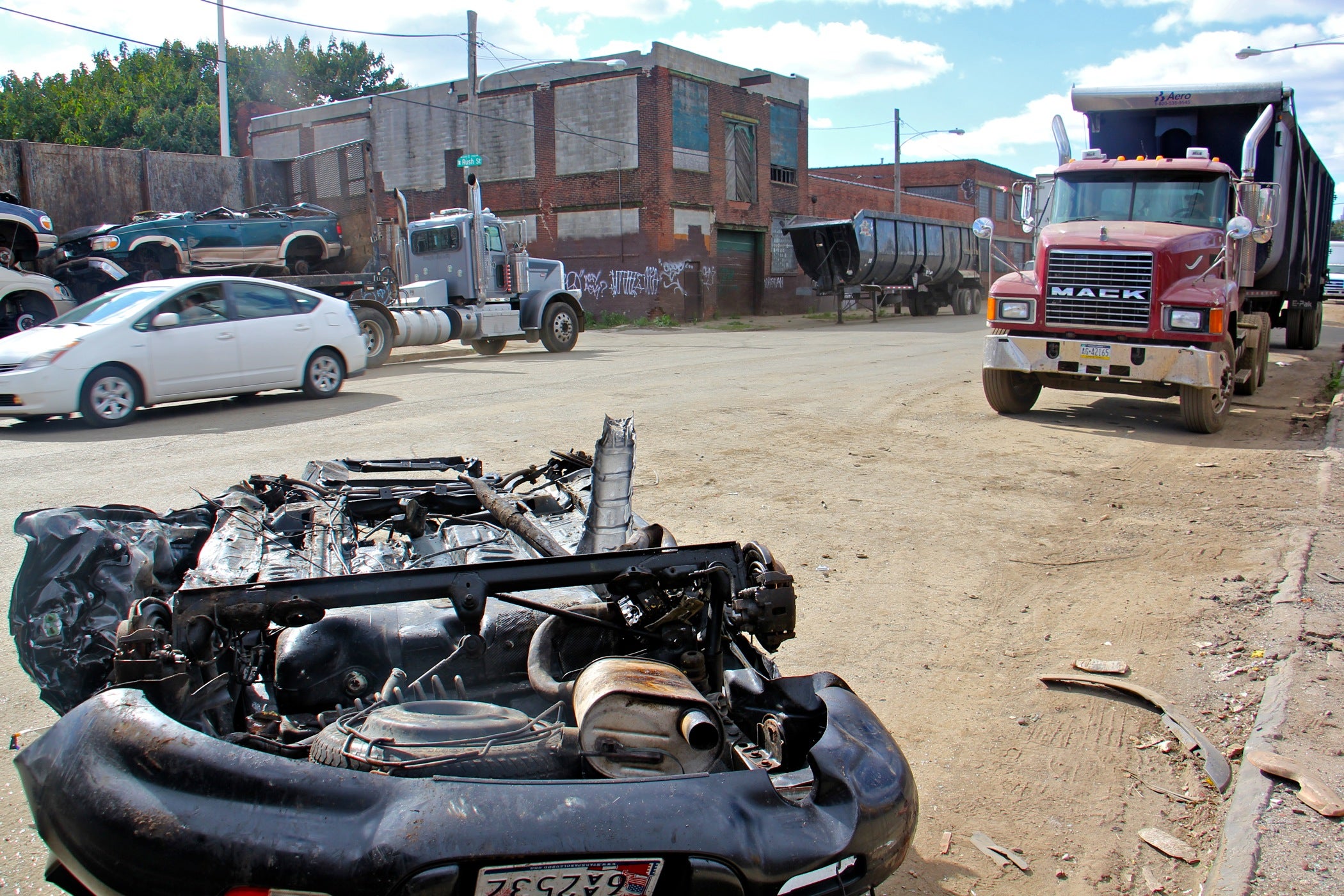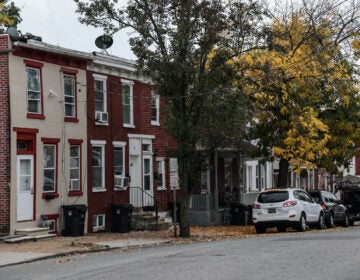Kensington’s hottest address? New homes to rise across from scene of scrapyard fire
Late Wednesday afternoon, Somerset LLC won a variance to enable their plan for the development of 153 housing units

A rendering of a proposed 2201 E. Somerset St. condo development submitted to Philadelphia's Civic Design Review board. (Atrium Design Group)
This story originally appeared on PlanPhilly.
—
Three months after a Kensington scrapyard erupted into a massive, four-alarm fire that inspired Elmo and enraged neighbors, a developer has won city approvals to build new homes across the street from the court-sanctioned dumping ground.
Late Wednesday afternoon, Somerset LLC won a variance to enable their plan for the development of 153 housing units on the site of an abandoned factory across the street from Philadelphia Metal and Resource Recovery, where the blaze erupted in July, spitting thick black smoke over the neighborhood.
“We are taking a blighted property that is essentially a menace and putting people and eyes on the street,” said Hercules Grigos, the zoning attorney for the developer, during a presentation before the Zoning Board of Adjustment.
The 2201 E. Somerset St. development lies to the southeast of the Somerset stop on the Market-Frankford Line, in the heart of the city’s opioid crisis, and just to the northeast of Lehigh Avenue which long served as a barrier beyond which developers were hesitant to cross.

Somerset LCC plans 23 single family townhomes, selling for around $300,000 and 66 duplex units selling for around $200,000. A rental apartment building facing Trenton Avenue would include 60 apartments, for between $600 and over $1,000 a month depending on the size.
New Kensington Community Development Corporation (NKCDC) testified against the project because the neighborhood’s zoning just got updated last year after intensive neighborhood input. The community group argued that variances shouldn’t be handed out for projects that chose to go beyond what is allowed in such a recently mapped zoning district.
Despite the opposition, the Zoning Board of Adjustment voted 3-to-1 to grant a variance to allow substantially less commercial space than is required. (Chairman Frank DiCicco was not in attendance for the vote.) The approval was not unexpected — Planning Commission data shows that the Zoning Board grants over 90 percent of variances and special exemptions.
“I wish I could say I was surprised, but I’m not,” said Andrew Goodman, community engagement director of NKCDC. “How will we continue to get community and merchant engagement if they know that only 20 percent of the time their opinion means anything?”
The crux of the disagreement is that under the parcel’s industrial-residential zoning, the developer should provide 27,764 square feet of industrial space, which can include “artisanal industry” or artist lofts, and 33,136 square feet of commercial space. But Somerset LLC only plans a combined 8,800 of both and sought the variance to waive the rest of the requirements.
The reason for avoiding the zoning requirement is that the developer doesn’t believe there is enough demand for businesses in the area. The developers’ attorney argued that more people walking the streets as residents would draw stores, restaurants, and other commercial services to the area.
“I think we want a lot of the same things, we are just trying to get there in a different way,” said Grigos. “We think residential will address these issues. Vacant commercial would not.”
Goodman told the zoning board about a forthcoming study of the neighborhood’s strong market potential by respected consulting firm Econsult. He said that the researchers identified commercial retail development as a viable option for the area. There are 516 new housing units coming online in the next few years from four major market-rate projects within two blocks of the scrapyard, including the 2201 E. Somerset project.
The 516 figure doesn’t count the new units provided by infill and a couple new, smaller affordable housing projects. Commercial storefront vacancy, meanwhile, is very low, and not just on the newly ritzy Frankford and Girard avenues.
A couple neighborhood residents spoke in favor of more storefronts that could be accessed on foot by the many residents who don’t own cars, either by choice or by economic necessity. Their concerns reflected the motivations behind NKCDC’s recommendation for parcels like 2201 E. Somerset to be zoned industrial-residential and the subsequent remapping that was skirted by the ZBA’s approval of Somerset LLC’s variance.
“Our stance is simple and clear: with a 100,000 square foot property one block away from a major commercial corridor, there is no reason to not adhere to the requirements of the zoning category,” said Goodman.

The ZBA isn’t the only municipal body that embraced the proposal. On Tuesday, the Planning Commission recommended that the board grant the variance. Earlier this month, the Civic Design Review board thought the project so well designed that they didn’t ask Somerset LLC to return for a second consideration.
On Tuesday, Planning Commission member Pat Eiding also said that any new development is needed right now to erase the industrial blight that still pocks the River Wards.
“Coming from where I am, I’m always I’m looking for industrial, always looking for commercial, always looking for jobs,” said Eiding, president of the Philadelphia Council AFL-CIO. “But when I go through my old neighborhood, things are just sitting there. The church I grew up in just there sitting deteriorating. You can’t just sit and watch it lay there forever.”
Eiding then asked about whether the developer expected Philadelphia Metal and Resource Recovery to be a long-term neighbor.
“We anticipate that it is [going away],” said Grigos at the Planning Commission. “We believe that our development is a catalyst for the development of the industrial sites around us and actually helps give this guy an exit strategy because it is a neighborhood nuisance.”
Grigos said that the last phase of the project would be duplexes planned for Somerset Street, facing the scrapyard. By the time ground is broken on the new homes, Somerset LLC hopes that the waste facility will be gone.
Besides the NKCDC representatives, a handful of near neighbors attended both the Planning Commission and the Zoning Board hearing to express their fears about gentrification and what they believe is the development’s potential for pushing out poorer residents.
But the one current occupant who the developer explicitly wishes to push out did not speak up during the hearing. In a brief phone interview, the owner of Philadelphia Metal and Resource Recovery said he didn’t have a position on the development project.
“The development crossing Lehigh heading north is inevitable,” said owner David Feinberg. “There’s nothing I can do to alter its course.”,
In September, a lawyer for Feinberg told the Philadelphia Inquirer that city officials were unfairly punishing the scrapyard for code violations because they wanted the business out of the gentrifying neighborhood.
“They want to redevelop that area, and take out industrial use, and put in residential use,” attorney Darlene Threatt told the Inquirer.”And nobody wants to live near a scrapyard.”
WHYY is your source for fact-based, in-depth journalism and information. As a nonprofit organization, we rely on financial support from readers like you. Please give today.







